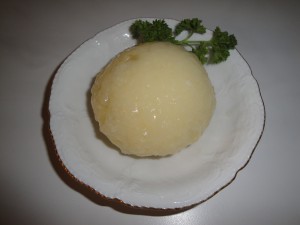City foods – Country foods
Article 2 of 4, starting with “What is German Cooking” and followed by “History of Bavarian Food”Again going back in history we can determine that country living came first and with this the only way to survive was to live off the land. In many cases the people or peasants were either paying tribute or were even owned by the local nobility. They tended their fields, had some chickens, a pig or two, one or two work oxen and if they were lucky a cow for milk.
Next villages were formed and some of the chores, like weapons manufacturing, hunting and others, were given to the people who established themselves as superior to the rest in these particular areas.
Life was tough and meat hard to come by, the land owners considered the animals in the forest their property and even the fish in the creek might have been claimed by the nobility.
If lucky the peasants or even “free” locals had a town nearby, where they could sell some of their harvest and also their crafts for money and in turn buy other necessities.
Once these towns and cities were established the population had to be fed and that brought us the Butcher, the Baker and even the Candlestick Maker. So life in the towns was centered around trading, bartering and eventually money and with that the more affluent commoners could occasionally afford meat. Again this treat was usually for the masters and their families only, which did not include their help. They were fed, but usually, with a mostly meatless diet.
This brings us to the older, basic Bavarian dishes, which very seldom contained meat. The protein content was mainly derived from legumes and eggs. (Eiweiss- egg white is the German name for protein)
Another little fact is that most of the food must have been grain based, as potatoes did not exist in Germany until they were planted for the first time in Pilgramsreuth, Upper Franken in the year 1647. After that all these dishes, like potato based noodles and dumplings snuck into local menus, took over a large percentage of side dishes and stayed there for good.
Even growing up over there after World War II, we usually had meat in our house daily, but it was portioned out and the bigger better cuts were only served at the Sunday dinner, the larger percentage of your daily food intake came from the side dishes.
Here’s a little story, at our house here in the USA we always go by the same advise we gave our customers in our meat store to figure on an average ½ pound of boneless or 1 pound of bone-in meat per person. So on a Saturday morning during our stay at my mother’s house in Germany, I went to the local butcher to buy a pork roast for a nice Sunday dinner for 8 of us. A “beautiful” piece of pork shoulder in the counter caught my eye and when I was waited on I decided to get the whole 5 pound piece. I actually was asked by one of the other customers, if I was, with that size piece, inviting the whole town for dinner, as by their customary portion size this roast should have fed at least 20 people.



